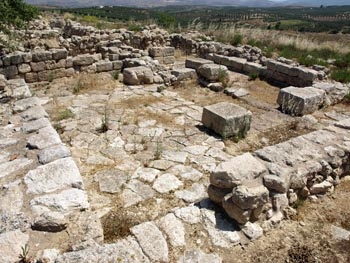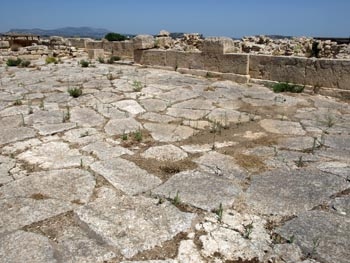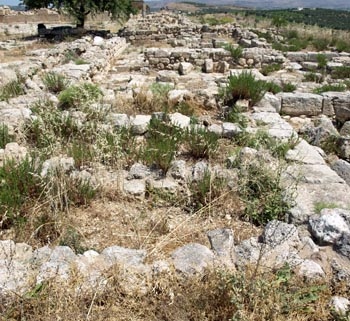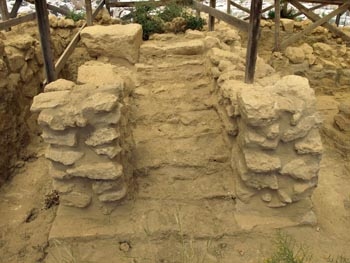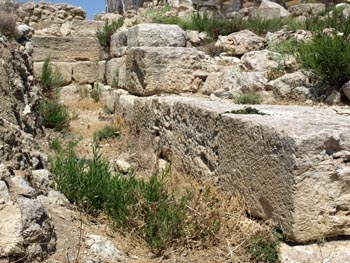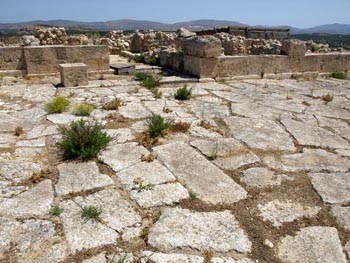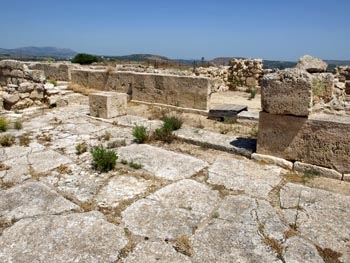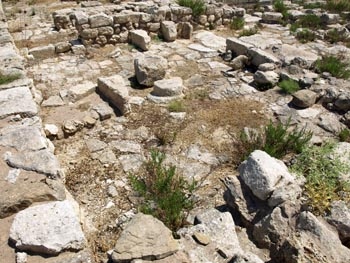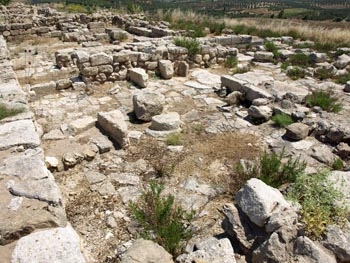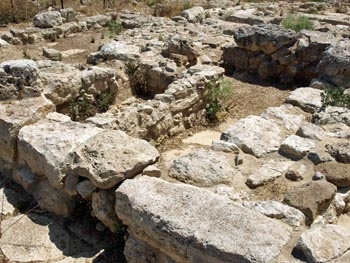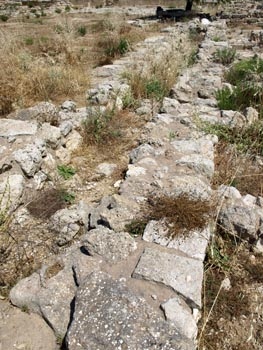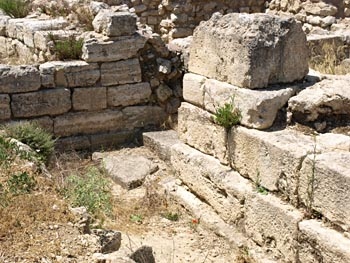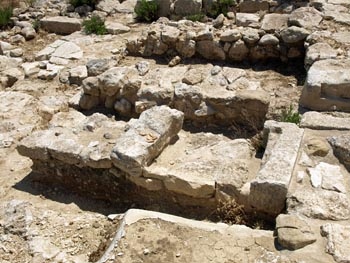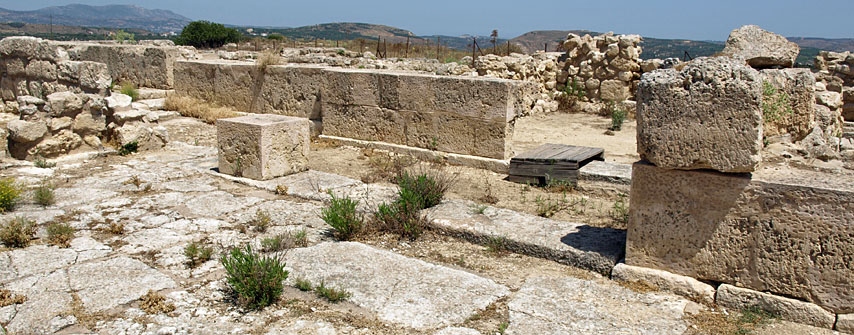
A recent discovery
The "Palace" at Galatas was only discovered and excavated in the early 1990s. The site is located 30 kilometres south of Heraklion, near the villages of Galatas and Arkalochori. From the site there are fine views of the surrounding countryside. The site is of particular importance as it contains a palace built only in one period, the neopalatial. Other palace sites contain remains from several palaces built at different times which often involved the levelling off and destruction of layers by the builders of the later palace and makes it more difficult to understand the architecture that remains. Excavations began in 1992 and in 1997 the archaeologist responsible for the excavations, George Rethemiotakis, announced that a new Minoan Palace had been found in the middle of a Minoan town. The excavation of the site was completed in 2005 although excavations continue in buildings outside the palace itself.
The large, paved central courtyard of the palace runs north-south and measures 16 metres by 32 metres. It was originally surrounded by a four-wing building. Of the four wings the East wing is the best preserved, while the west and south wings are in very poor condition. The north wing has now also been excavated. The north end of the central court has a face of ashlar masonry and some 50 blocks have masons' marks on them. All the original frescoes have unfortunately been lost although a few fragments remain.
The town
Although the palace at Galatas dates from the New Palace period, a thriving town was already in existence on the hillside in the Old Palace period. A building in the West Wing of the later palace showed evidence of centrally controlled activity in a non-palatial setting. In a building no more than 40 square metres there was evidence that the grinding of grain was being organised on a scale much larger than would be necessary simply for the people living there. Seventy grinders and querns were uncovered as well as hundreds of drinking vessels, which suggested that feasting ceremonies may have taken place in the rooms on the upper floor of the building. Some of the ceramics were from Knossos and Phaistos and part of an ivory handle from a sword was also found suggesting a high profile individual either lived in the building or supervised the work and/or the ceremonial feasting.
Slightly later, in Middle Minoan III, a mansion was built where the East Wing of the Palace would later stand. The Mansion was extensively damaged by fire, still in MM III, and the lower remains of the Mansion became incorporated into the East Wing of the palace. In the Pillar Hall (room 17) of the East Wing for the first time in Minoan Crete a hearth was discovered together with a layer of ash. The hearth measures 3 metres by 1.5 metres and was found in a room with four pillars (see photos). Beneath the ash layer an example of Knossian influence at Galatas was found in the form of a fragment from a wall painting showing part of a landscape. It dates to Middle Minoan IIIA.
The MM IIIB palace
The palace itself belongs to one main building phase dating to MM IIIB/LM IA. The builders seem to have stuck to the original plan for the palace, making only one or two changes as construction proceeded. The most important change was the inclusion of a stoa in the West Wing of the palace. After the destruction of the East Wing villa the builders pulled down the upper parts of the walls, used the rubble to fill in the gaps, raised the floors and used the lower sections of the walls which still stood as the foundations for the East Wing of the palace itself.
The East Wing
The East Wing, which remains the best preserved of the four wings around the central court, measures 70 metres by 60 metres. It was used for cooking, for feasting and social gatherings in the central hall, for storage and possibly for making official appearances from balconies on the upper floor. Cooking eating and drinking seem to have been a major occupation of the palace residents given the size of the areas available for these activities and the enormous number and wide range of vessels suited to such activities which were found at locations all over the palace. Only the Cooking Place (rooms 11 and 12, which were added in MM IIIB) was not part of original architectural lay-out.
Giorgos Rethemiotakis proposes two areas on the ground floor of the East Wing where ceremonial feasting may have taken place -- the Pillar Hall (room 17) and the Column Hall (room 14). He argues that "the use of a monumental hearth in one of the rooms, the preparation of meals in the kitchen and the banquets offered in the room with the hearth and the room with the pillar and the benches or even upstairs, the storing of goods in the store rooms along with the personal appearances of the participants on the balconies toward the town and the central court of the palace, represent a symbolic meeting of the Town and the Palace which is ratified by the banquets".
At the north end of the West Wing similar ceremonies were possibly taking place in room 22. The room was probably abandoned before the final destruction like the Cooking Place in the East wing was. Nevertheless, eating, drinking and perhaps, based on finds, purification rituals took place here around a platform and adjacent circular hearth. Finds here included a large number of cups and jugs, animal bones and some incense burners.
The large scale consumption of food and drink was not confined to the palace itself, but was also repeated in houses close to the palace. Building 1, which lies 100m southeast of the palace and building 3, at the northwest corner of the north wing, both provide evidence, such as large quantities of tableware and animal bones, that what the elite were doing in the palace was also being copied by better off people in the town.
The excavator points out that to consume at this level it would have been necessary to have direct or indirect control of a large rural area and quantities of livestock in the countryside surrounding the palace. This is attested by the huge number of implements for grinding grain that were found throughout the palace. Querns, which were used for the grinding of grain into flour vastly outnumber other types of grinders.
The North Wing
The North wing contained the residential area for palace officials. The building was clearly important. It had the most impressive facade onto the central court. Five wide windows along the facade opened onto the court and it is likely that there were similar windows on the upper floor.
All three rooms with the windows, (rooms 42, 46, 45; see plan) were planned as a distinct unit as there was communication between the rooms but only one entrance to them from outside. Access to the equivalent rooms on the upper floor was controlled from room 51 through staircase 53 and 50 and northwards through corridor 52 to the significant official apartments of the wing. These include a Minoan Hall and associated rooms (54, 48b, 55, 56) a staircase (48a) and other rooms.
The construction materials used to build the north wing also attest to its importance. Thin white plaster was spread on the floors, while red was used on the steps of the staircase. Dressed masonry was used in the walls of the light well and the door jambs were made of gypsum, making this the only wing in the palace to have such luxury. Because the palace was deserted before its final destruction in LM IA, very little was found in these areas.
Crisis hits Galatas
When we get to LM IA something seems to go wrong at Galatas. Whole areas of the palace are suddenly abandoned. The sort of valuable objects that you would expect to find in a destruction level are simply not there. Very little pottery from the LM IA period has been found and it seems that the custom of holding communal meals either dramatically declined or even came to an end completely. In the East wing, the magazines (rooms 5-10) and the Cooking Place (11, 12) used for storing and preparing food for the whole palace are abandoned. Doors and staircases to the upper floor 16, 19-20, are blocked off. The Column Hall (14) becomes a kitchen. Only the Pillar Hall seems to keep its function as a reception area and gathering place to the very end.
In the north wing access to and from the central court is cut off by walling up the door between the forehall (39) and corridor (43), so that the area can no longer be used as before. The door on the corridor of room 42 is sealed so that the group of three rooms with their five ground floor windows (42, 45 46) go out of use. Access to staircase 50-53 is closed off, ending access to the rooms on the top floor which face the central court while room 51 is turned over to milling.
In the last period of occupation, what remained in use in the north wing was completely cut off from the functions of the central court, which to judge by the finds there had also become a grinding area. Long after the rest of palace had collapsed, the residential quarter still remained in use as evidenced by the presence of some LM IA pottery.
It seems that during the last phase of occupation the palace had pretty much ceased to operate as a central building and that activities were carried out on a much smaller scale in different parts of the building, for example the Column and Pillar Hall in the East wing and the Minoan hall in the north wing.
Rethemniotakis believes that the whole area around the palace, known as Pediada, was hit by a sudden crisis. He supports this view with some evidence from the local area. For example, at the remote cave at Arkalochori excavators found the remains of what he believes to have been a large shipment of sacred metal that was going to be melted down. According to Rethemniotakis it was probably hidden in the cave to protect it from looting but nobody ever went back to claim it because of the crisis that overtook the whole area.
Whatever the crisis was, the palace of Galatas never recovered. Minoan Crete prospered throughout LM IA but Galatas and its hinterland did not. After the destruction and abandonment of the palace recovery starts in LM IB but in the town, not the palace. Old buildings are repaired or rebuilt. There is evidence that the grinding of grain continues as a major occupation, especially in building 2. In building 3, we see a development common in much of Crete in LM IB -- the turning over of part of the residential area to house the expansion of storage space. The dining hall was also abandoned which seemed to signal the final end of the ceremonial feasts.


